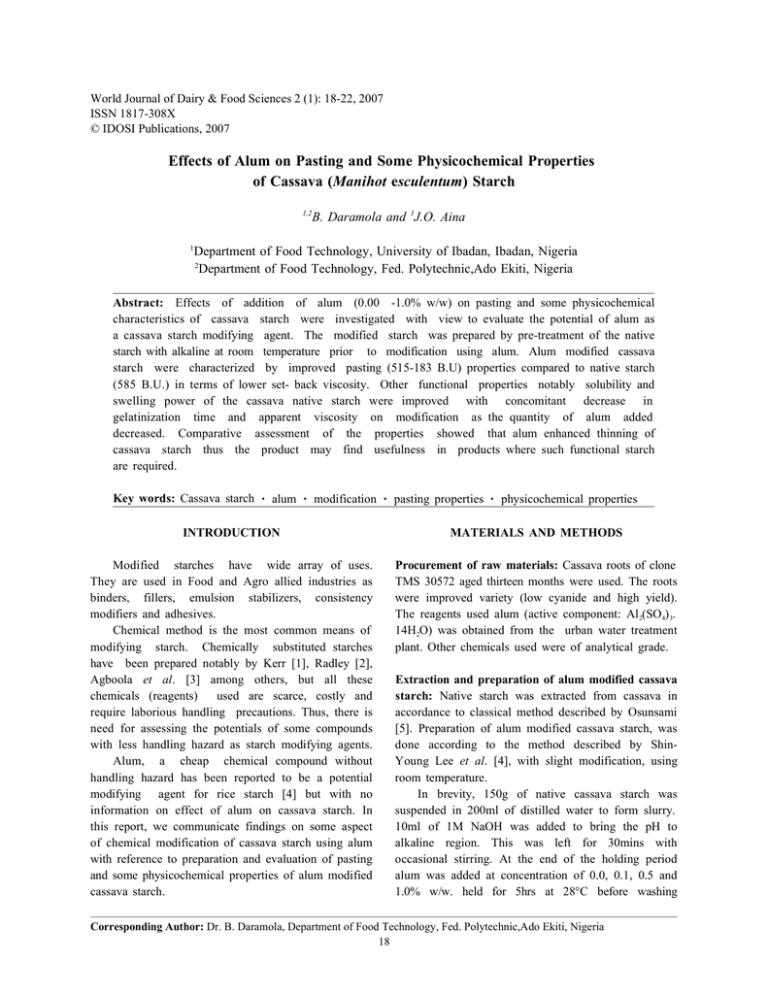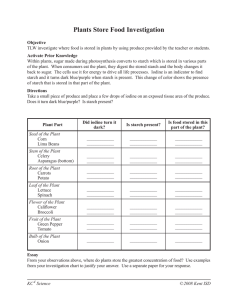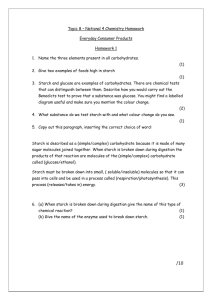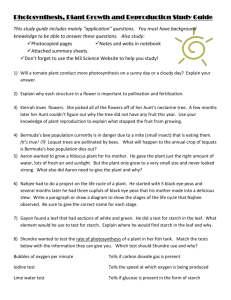World Journal of Dairy & Food Sciences 2 (1): 18-22,... ISSN 1817-308X © IDOSI Publications, 2007
advertisement

World Journal of Dairy & Food Sciences 2 (1): 18-22, 2007 ISSN 1817-308X © IDOSI Publications, 2007 Effects of Alum on Pasting and Some Physicochemical Properties of Cassava (Manihot esculentum) Starch 1,2 1 B. Daramola and 1J.O. Aina Department of Food Technology, University of Ibadan, Ibadan, Nigeria 2 Department of Food Technology, Fed. Polytechnic,Ado Ekiti, Nigeria Abstract: Effects of addition of alum (0.00 -1.0% w/w) on pasting and some physicochemical characteristics of cassava starch were investigated with view to evaluate the potential of alum as a cassava starch modifying agent. The modified starch was prepared by pre-treatment of the native starch with alkaline at room temperature prior to modification using alum. Alum modified cassava starch were characterized by improved pasting (515-183 B.U) properties compared to native starch (585 B.U.) in terms of lower set- back viscosity. Other functional properties notably solubility and swelling power of the cassava native starch were improved with concomitant decrease in gelatinization time and apparent viscosity on modification as the quantity of alum added decreased. Comparative assessment of the properties showed that alum enhanced thinning of cassava starch thus the product may find usefulness in products where such functional starch are required. Key words: Cassava starch alum modification pasting properties physicochemical properties INTRODUCTION MATERIALS AND METHODS Modified starches have wide array of uses. They are used in Food and Agro allied industries as binders, fillers, emulsion stabilizers, consistency modifiers and adhesives. Chemical method is the most common means of modifying starch. Chemically substituted starches have been prepared notably by Kerr [1], Radley [2], Agboola et al. [3] among others, but all these chemicals (reagents) used are scarce, costly and require laborious handling precautions. Thus, there is need for assessing the potentials of some compounds with less handling hazard as starch modifying agents. Alum, a cheap chemical compound without handling hazard has been reported to be a potential modifying agent for rice starch [4] but with no information on effect of alum on cassava starch. In this report, we communicate findings on some aspect of chemical modification of cassava starch using alum with reference to preparation and evaluation of pasting and some physicochemical properties of alum modified cassava starch. Procurement of raw materials: Cassava roots of clone TMS 30572 aged thirteen months were used. The roots were improved variety (low cyanide and high yield). The reagents used alum (active component: Al 2(SO4)3. 14H2O) was obtained from the urban water treatment plant. Other chemicals used were of analytical grade. Extraction and preparation of alum modified cassava starch: Native starch was extracted from cassava in accordance to classical method described by Osunsami [5]. Preparation of alum modified cassava starch, was done according to the method described by ShinYoung Lee et al. [4], with slight modification, using room temperature. In brevity, 150g of native cassava starch was suspended in 200ml of distilled water to form slurry. 10ml of 1M NaOH was added to bring the pH to alkaline region. This was left for 30mins with occasional stirring. At the end of the holding period alum was added at concentration of 0.0, 0.1, 0.5 and 1.0% w/w. held for 5hrs at 28°C before washing Corresponding Author: Dr. B. Daramola, Department of Food Technology, Fed. Polytechnic,Ado Ekiti, Nigeria 18 World J. Dairy & Food Sci., 2 (1): 18-22, 2007 Measurement of apparent viscosity: This was measured according to the method described by Myers and Smith [10]. Cassava starch Starch slurry Alkalizing (10ml of 1MNaOH) Measurement of sulphate content: This was determined as elicited in Vogel [11]. A 5ml of 1% w/w starch suspension in distilled water was pipette into conical flask. 5ml of conditioning reagents (water, sodium chloride, propan-2-ol, concentrated HCl and glycerol at ratio: 4:1:1:1/2:2/3 respectively) was added with standardized barium chloride solution this was boiled immediately on a magnetic stirrer for a minute. The absorbance of the paste was measured at wavelength of 420 nm. With reference to blank determination using distilled water, sulphate content was calculated from sulphate standard curve. Holding (30mins, 28°C) Addition of alum (0.1, 0.5 and 1.0% w/w) Holding (5h, 28°C) Washing Vacuum filtration Drying (50°C, 12h) Milling Alum modified cassava starch Fig. 1: Flow chart for the preparation of alum modified cassava starch Paste clarity determination: This was determined from % light transmittance (%T) of starch paste as described by Craig et al. [12]. thoroughly with distilled water through Watchman no. 4 filter paper using vacuum pump and then dried at 50°C in air oven to desired moisture content and cooled starch were milled into powder and package for subsequent analysis (Fig. 1). Determination of pasting properties: The pasting properties of modified and native cassava starch were determined using the Brabender visco amylograph as described by Mazurs et al. [13]. The visco -analyser was equipped with a 700cmg sensitivity cartridge operating at a bowl speed of 75rpm. The procedure used is as follows: starch slurry containing 10% solid (dwb) was prepared and cooked by the equipment, viscosities were measured by heating the slurries at the rate of 2.5°C/min from room temperature to 95°C, held for 30mins at that temperature. Viscosities of technological significance were identifies and evaluated. Physicochemical characterization of alum modified and native cassava starch: Determination of moisture content: moisture content of samples were determined using weight reduction method as described by AOAC [6]. Determination of percent recovery: The percent recovery of alum modified starch was determined by weighing the dried modified starch, correcting for moisture and comparing with the dry weight of the native starch [3]. RESULTS AND DISCUSSION Measurement of pH: The pH of the starch samples were determined by using an Omega H. HPX digital pH meter. Standardization of the meter was done using buffer solution of pH 9 and 4. A 5g sample was dispersed in 50ml of distilled water and the mixture was subjected to stirring until an equilibrium pH was attained and the pH was measured [7]. Physicochemical characteristics of alum-modified and native cassava starch: The result of the physicochemical characteristics considered is as shown in Table 1. Moisture content, percent recovery and pH of alum modified and native starch: The moisture contents of the alum modified and native cassava starch were similar, they range from 11.2%- 11.5%. The moisture content of starch depends to a large extent on the method of drying and drying conditions [14]. The recovery of alum modified starch range from 92.5 to 98.0%, these were much higher under the condition Determination of swelling power: swelling power was determined according the method of Leach et al. [8]. Determination of solubility: solubility was evaluated in accordance with the method of Kainuma et al. [9]. 19 World J. Dairy & Food Sci., 2 (1): 18-22, 2007 Table 1: Physicochemical acharacteristics of alum modified and native cassava starch Conc.of alum in starch sample Swelling Recovery (%) pH power Solubility(%) Moisture App. Sulphate Paste content (%) viscosity (cp) content (mg/g) clarity (%T) 63.0 0.1% 98.0 7.2 11.7 16 11.5 17 0.168 0.5% 98.0 6.2 12.5 16 11.2 16 0.174 74.0 1.0% 97.0 4.6 15.8 21 11.3 15 0.184 71.0 Native starch NA 6.2 10.2 14 11.2 20 0.142 72.0 NA=Not Applicable, aAverage of three determinations Table 2: Brabender amylograph reading for alum modified and native cassava starch Conc.of alum in starch sample Pt (°C) PV (BU) SV (BU) GT(min) 0.1% 68.50 710 V95oC (BU) 380 245 465 3.00 76.5 0.5% 70.00 570 385 250 320 3.50 78.8 1.0% 68.25 220 80 37 183 2.80 75.0 Native starch 66.25 820 360 235 58.8 4.00 75.0 Pt = Pasting temperature, PV/t = Peak viscosity/temperature, V o 95 C V o 50 C (BU) = Viscosity at 95°C, V o 50 C PT (°C) = Viscosity at 50°C, SV = set-back Viscosity, GT =Gelatinization time, PT= Peak viscosity temperature used in this study (Slurry method) than the 39-53% recovery obtained by reflux method of Osunsami [5] The low percent recovery observed by Osunsami [5] may be due to great heat damage and solubilization as a result of heating for an appreciable length of time [15]. The pH value of the alum modified cassava starch decreased from 7.2 to 4.6 while the pH of the native cassava starch was 6.2. Apparent viscosity: The apparent viscosities (2-17cp) of the alum modified starch were lower compared to apparent viscosity of the native starch (20cp). Pseudoplasiticity of the alum modified starch increase as quantity of alum added increases. This is thought to be due to substitution of sulphate group into the hydroxyl site of starch molecule. This substitution prevents re-association of units of molecule in starch. This result is similar to an earlier report made by ShinYoung Lee et al. [4] on gelatinized waxy rice starch. Swelling power: The swelling power of the alummodified starch (11.7-15.8) was higher than that of the native starch (10.2). The swelling power increase as the quantity of alum added increased. The swollen of the starch granules was as a result of incorporation of water molecules into hydrophilic group of the starch molecules that have been hydrolysed, coupled with substitution of sulphate groups in place of some of the hydroxyl groups that have been displaced and this substituted group prevents re-association of hydrolysed glucose units in the starch molecule thereby exerting imbibition of water molecules and subsequently prevent crystallization of starch molecules. Sulphate content of samples: Sulphate content of alum modified starch is as presented in Table 1. The amount of endogenous sulphate in the native starch was found to be 0.142 mg/g of starch while the amount of sulphate in the alum modified starch increase as concentration of alum increased (Table 1). In addition, it also appears that the amount of sulphate substitution when sample was treated with alum at concentration of 0.1 and 0.5% were not too different. This suggests plausity in treatment of sample with alum at concentration of 0.1%. This is desirable because substitution of starch for use in foods need not be very high degree [16]. Solubility: The alum modified starch were insoluble in water at room temperature and as a result, solubility was determined at a temperature of 60°C. The solubility in percentage of the alum modified starch were higher than that of the native starch (Table 1.). The solubility of the alum modified starch increases with increase in alum concentration. Paste clarity: The percent transmittance (71-81%T) obtained for the alum modified starch appeared to be higher than found (72%T) for the native starch. Considering Craig et al. [12] hypotesis, the result observed for the paste clarity give credence to the result obtained for swelling power and solubility, the hypotensis states that the more starch swell or dispersed the greater its percent transmittance. 20 World J. Dairy & Food Sci., 2 (1): 18-22, 2007 The potential of alum to confer improvement on stability of cassava starch paste coupled with its desirable attributes of low cost and safe handling shall make alum a desirable modifying agent for enhancing functionality of cassava starch thus facilitating elimination of the major drawback [18] identified in the cooked native starch. Knight [18] reported that cassava starch is easy to modified because of its high paste clarity, bland taste and compared favourably with the much cherished corn starch in physical properties but it is characterized by poor paste stability. CONCLUSION Modification of cassava starch using alum under the conditions employed in this study gave starch with improved cooking stability, swelling power, solubility and decrease in apparent viscosity. Generally, alum modified cassava starch exhibited thinning characteristics thus can be incorporated into foods where such functional properties are desired. Fig. 2: Brabender visco amylograph of alum modified and native cassave strach Pasting properties: The pasting properties of the alum modified and native starch is as presented in Table 2 and Fig. 2. The peak viscosity of the alum modified starch generally reduced compared to the peak viscosity of the native starch, this is most likely due to the effect of substitution in the hydroxyl group by sulphate group from the alum. Similar observation had been reported by Osman [17] during acid modification of cassava and potato starches. Added to this Knight [18] reported reduced viscosity curves at lower pH, (acidic pH) values for waxy corn starch. For the alum modified starch, the viscosity was reducing as concentration of alum was increased. All the alum modified starch cooked at a lower time as revealed by gelatinization time (2.6-3.5 mins) compared to the native starch (4 mins). This implies ease of cooking of the alum modified starch granules which have been weakened by substitution. This result is in agreement with the report made by Agboola et al. [3] on acetate and citrate substituted cassava starch. The set-back viscosities of the cooked paste were lower (between 183 and 515 BU) for the alum modified starch as compared to high set-back viscosity (585 BU) of the native starch. According to Mazurs et al. [13] low set-back viscosities reflect the stability of the cooked paste which implies reduced tendency to retrograde. Retrogradation has been attributed to the linear fraction of molecular starch (amylose) and the introduction of subtitution group interfere with re-alignment of the linear fractions and consequently reduced manifestation of retrogradation. REFERENCES 1. 2. 3. 4. 5. 6. 7. 21 Kerr, R.W., (ed), 1950. Chemistry and Industry of starch 2nd Edn., Academic Press, Inc. New York, pp: 689-693. Radley, J.A., 1967. Examination and Analysis of starch and starch products. John Wiley, Inc. New York, pp: 418-425. Agboola, S.O., J.O. Akingbala and G.B. Oguntimehin, 1990. Production of low substituted cassava starch acetates and citrates. Starke/Starch, 43: 13-15. Shin-Young, Lee, L. Sang-Gui and Ik-boo kwon, 1995. Effect of alum on the rheological properties of gelatinized solutions of non-waxy rice starches. Korea Journal of Food Science and Technology, 27: 776-782. Osunsami, A.T., 1987. Investigation of Optimum conditions for the isolation and modification of cassava starch. M.Sc. Thesis, Department of Food Technology, University of Ibadan. AOAC, 1990. Official Methods of Analysis. 14th Edn. Association of Official Analytical Chemists. Washington DC. Smith, R.J., 1967. Characteristics and Analysis of starches, in Starch: Chemistry and Technology, Industrial Aspects (R.L. Whistler and E.F. Paschal, Eds.) Academic Press, New York, 2: 569-631. World J. Dairy & Food Sci., 2 (1): 18-22, 2007 8. 9. 10. 11. 12. 13. Leach, H.W., L.D. Mc. Cowen and T.J. Schoch, 1959. Structure of the starch granules, in: Swelling and solubility patterns of various starches. Cereal Chemistry, 36: 534-544. Kainuma, K., T. Odat and S.Cuzuki, 1967. Study of starch phosphates monoesters. J. Technol. Soc. Starch, 14: 24-28. Myers, R.R. and R.J. Smith, 1964. Inherent viscosity of alkaline starch solutions. Methods Carbohydrate Chem., 4: 124. Vogel, A.I., 1989. Text book of quantitative chemical analysis Ed: Jeffery, GH, Bassekt J, Mendham J, Denny R.C. 5th Edn. Longman Group UK Limited England, pp: 729. Craig, S.A.S., C.C. Mainngat, P.A. Seib and R.C. Hosenet, 1989 starch paste clarity. Cereal Chem., 66: 173-174. Mazurs, E.G.T.J. Schoch and F.E. Kite, 1957. Graphical analysis of the brabender viscosity curves of various starches. Cereal Chem., 34: 141-153. 14. Shildreck, P. and C.E. Smith, 1967. Production and uses of acid modified starch. In starch: Chemistry and Technology Vol. II Industrial Aspects. Whistler R.L. and E.F. Paschal (Eds.). Academic Press, New York, pp: 217-273. 15. Brautletch, C.A., 1953. Starch: In” Sources, Production and Uses, Reinhold Publishing Corporation, New York, 3rd Edn., pp: 217 219. 16. Roberts, H.J., 1967. Starch derivatives. In starch: Chemistry and Technology. Industrial Aspects. R.L. Whistler and E.F. Paschal, (Eds.) Academic Press, New York, 2: 293-334. 17. Osman, E.M., 1967. Starch in the food industry, On Starch: chemistry and Technology. Industrial Aspects. R.L. Whistler and E.F. Paschal, (Eds.) Academic Press, New York, 2: 163-210. 18. Knight, J.W., 1974. Speciality food starches in: Cassava processing and storage proceedings of an Inter-disciplinary workshop, Pattaya, Thailand. International Development Research Centre (IDRC) pp: 76-87. 22








